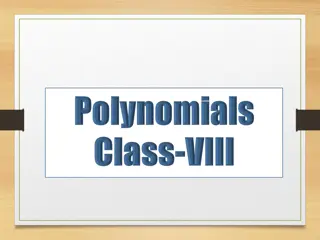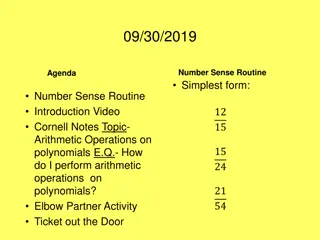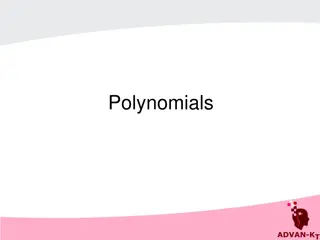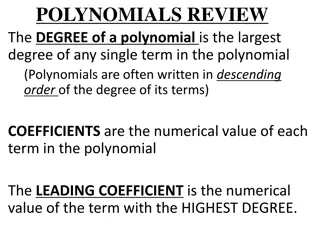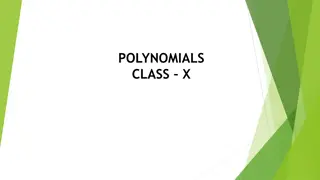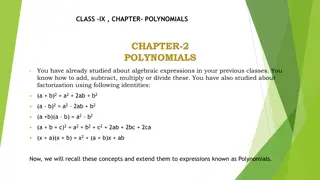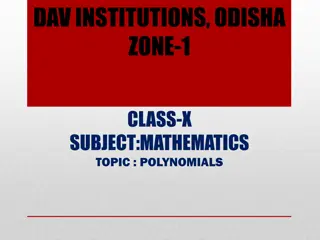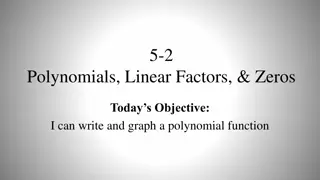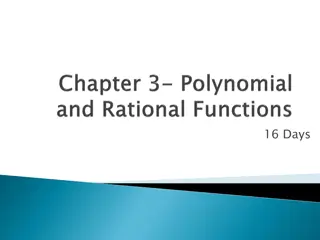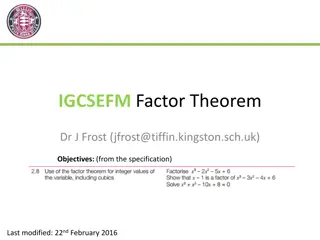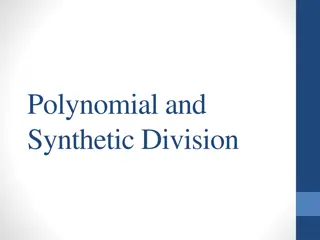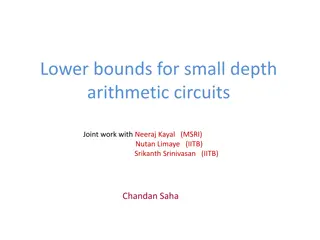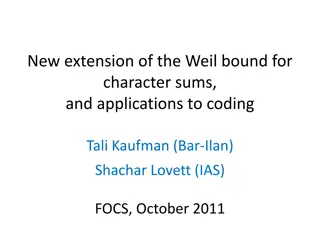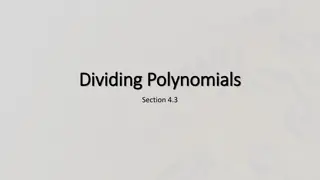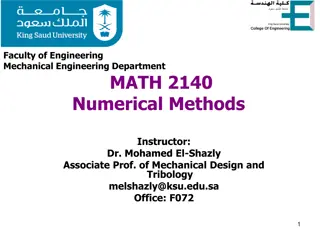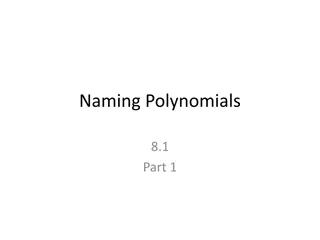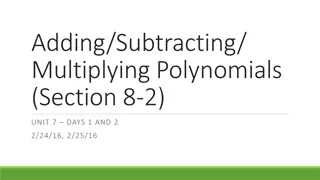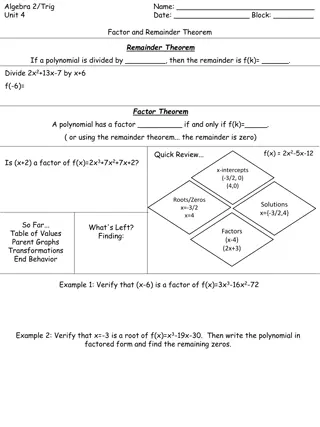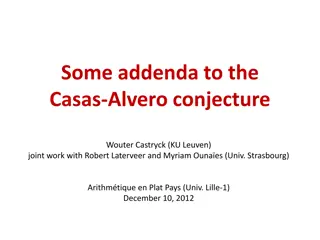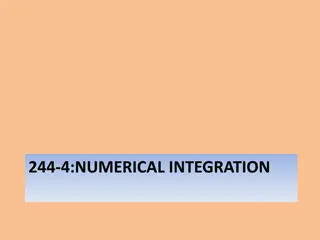Galois Theory and Field Extensions
Explore the fundamental concepts of Galois theory, field automorphisms, prime subfields, and field extensions. Learn how symmetries and polynomials play a crucial role in creating new mathematical objects, and understand the significance of field extensions in adjoining roots of polynomials. Delve i
11 views • 14 slides
Polynomial Basics: Definitions, Classification, and Operations
Learn the fundamentals of polynomials, including defining polynomials, determining degrees, classifying by terms, writing in standard form, and performing operations like multiplication and division. Understand monomials, binomials, trinomials, coefficients, and degrees of polynomials in a straightf
5 views • 36 slides
Introduction to Arithmetic Operations on Polynomials
This unit focuses on developing an understanding of polynomials in mathematical expressions. You will learn about the parts of a polynomial, polynomial operations, and representing polynomials. The topics cover performing arithmetic operations on polynomials, identifying variables in expressions, le
2 views • 71 slides
Polynomial Functions and Operations
Polynomial functions are mathematical functions in the form of an expression involving variables and coefficients. They can be manipulated through operations like addition, subtraction, multiplication, and division. Learn about polynomial degrees, identifying polynomials, and performing various oper
2 views • 20 slides
Polynomials: Degrees, Coefficients, and Graphs
Explore the essential concepts of polynomials, including degrees, coefficients, and graph shapes. Learn to identify leading coefficients, degrees, and relationships between polynomial functions and their graphs. Practice finding values of polynomials and analyzing the impact of degrees on the number
7 views • 16 slides
Polynomials and Their Zeroes: A Comprehensive Overview
Explore the world of polynomials, from linear to quadratic to cubic, and understand the concept of degrees, zeroes, and their geometrical meanings. Learn how to determine the value of polynomials at specific points and find the zeroes of different types of polynomials through clear examples and expl
4 views • 14 slides
Polynomials: Types, Degrees, and Zeroes
Polynomial expressions consist of terms with non-zero coefficients. They can have any number of terms and different degrees. Linear polynomials have a degree of one, quadratic polynomials have a degree of two, and cubic polynomials have a degree of three. Zeroes of a polynomial are the values of the
0 views • 17 slides
Polynomials and Algebraic Expressions
Dive into the world of algebraic expressions and polynomials, exploring concepts like constants, variables, coefficients, and degrees. Learn how to identify terms, understand polynomial types based on degrees, and solve related mathematical problems.
0 views • 12 slides
Polynomials in Mathematics
Explore the concept of polynomials in mathematics, including the geometrical meaning of zeroes, the relationship between zeroes and coefficients, and the division algorithm. Learn about the degree of polynomials, value of polynomials, and how to identify and factorize them. Discover algebraic expres
1 views • 46 slides
Eigenvalues and Characteristic Polynomials
Unravel the mystery of eigenvalues and characteristic polynomials through detailed lectures and examples by Hung-yi Lee. Learn how to find eigenvalues, eigenvectors, and eigenspaces, and explore the roots of characteristic polynomials to solve characteristic equations. Dive into examples to discover
3 views • 19 slides
Polynomials: Zeros, Factors, and Graphs
Understanding polynomials, linear factors, and zeros. Learn how to write and graph polynomial functions, find roots and x-intercepts, apply the Factor Theorem, and plot graphs using zeros and end behaviors.
5 views • 4 slides
Polynomials and Graphs through Real-World Analogies
Explore the relationship between mountain ranges and polynomials, and learn how to apply the Intermediate Value Theorem to find zeros of polynomial functions. This guide covers concepts like the Interval Value Theorem, sketching graphs of higher-degree polynomials, and constructing tables to analyze
4 views • 85 slides
Insights into Graph Colorings, Chromatic Polynomials, and Conjectures in Discrete Geometry
Delve into the fascinating world of graph colorings, chromatic polynomials, and notable conjectures in discrete geometry. Explore the impact of June Huh in bringing Hodge theory to combinatorics and his proof of various mathematical conjectures. Uncover the significance of the four-color theorem, co
4 views • 17 slides
Division of Polynomials using Remainder and Factor Theorem
Explore the concept of dividing polynomials to find remainders and factors, illustrated through examples and explanations. Learn how to apply the Remainder and Factor Theorem to determine remainders, factors, and solve related problems. Test your understanding with practical questions.
0 views • 17 slides
Polynomial and Synthetic Division Techniques
Learn how to perform polynomial division using long division and synthetic division methods. Understand how to divide polynomials by other polynomials or binomials, utilize the Remainder Theorem and Factor Theorem, and apply these concepts through detailed examples.
1 views • 41 slides
Lower Bounds for Small Depth Arithmetic Circuits
This work explores lower bounds for small-depth arithmetic circuits, jointly conducted by researchers from MSRI, IITB, and experts in the field. They investigate the complexity of multivariate polynomials in arithmetic circuits, discussing circuit depth, size, and the quest for an explicit family of
4 views • 114 slides
New Extension of the Weil Bound for Character Sums
Tali Kaufman and Shachar Lovett present a new extension of the Weil bound for character sums, providing applications to coding theory. The Weil bound offers insights into the behavior of low-degree polynomials, distinguishing between structured and random-like functions. This extension has implicati
2 views • 28 slides
Insights into Polynomials Vanishing on Cartesian Products and the 3POL Problem
This joint work explores polynomials vanishing on Cartesian products, focusing on the 3POL problem involving three sets of points and a 6-variate polynomial. It discusses the running time of solving the explicit 3POL problem and compares it to the well-studied 3SUM problem in theoretical computer sc
2 views • 29 slides
Polynomial Division Methods
Learn how to divide polynomials using long division and synthetic division techniques. Explore the processes of dividing polynomials by other polynomials or binomials, using the Remainder Theorem, and applying synthetic division to evaluate polynomials. Master the steps with detailed examples and vi
5 views • 14 slides
Newton's Interpolating Polynomials in Mechanical Engineering
Explore Newton's interpolating polynomials in the context of Mechanical Engineering, specifically focusing on numerical methods and interpolation techniques. Dr. Mohamed El-Shazly, an Associate Professor of Mechanical Design and Tribology, guides students through the concepts and applications of New
3 views • 17 slides
Polynomials: Types and Naming Conventions
Delve into the world of polynomials with definitions, examples, and explanations of how they are named based on the number of terms they contain. Learn about monomials, binomials, trinomials, and general polynomials, along with insightful images to aid your understanding.
2 views • 33 slides
Polynomials Operations: Adding, Subtracting, Multiplying - Unit 7 Days 1 and 2
Dive into the world of polynomial operations in this engaging unit covering adding, subtracting, and multiplying polynomials. Explore methods to combine like terms, distribute negative signs, and apply polynomial operations to solve problems. Practice sorting gumballs with like terms and creating nu
3 views • 23 slides
Polynomial Factor and Remainder Theorems
Exploring the Factor and Remainder Theorems in algebra, including examples on verifying factors, finding roots, applying the Rational Root Test, and determining zeros of polynomials. Learn how to factor polynomials, find remaining zeros, and analyze coefficients to uncover the complete factorization
2 views • 6 slides
Zeroes of Polynomials - Grade 9 Chapter 2
Zeroes of a polynomial are the values of the variable that make the polynomial equal to zero. This concept is explored in Grade 9 Chapter 2, where students learn how to find the zeroes of a polynomial by equating it to zero. Through examples like p(x) = x - 4, students understand how to determine th
3 views • 10 slides
Addenda to Casas-Alvero Conjecture: Polynomial Derivatives and Common Roots.
In this research work, the Casas-Alvero conjecture is explored, focusing on polynomials and their derivatives, and the common roots they share. The study delves into the normalization of roots under various transformations, using p-adic methods and Gröbner bases. Noteworthy findings include implica
1 views • 24 slides
244-4:NUMERICAL INTEGRATION
Numerical integration involves methods such as Simpson's rule, higher-order formulas, and built-in functions in MATLAB/Python for evaluating integrals. Simpson's rule divides a range into subdivisions and approximates the integral using second-degree polynomials. Higher-order formulas use higher-deg
3 views • 11 slides
Theory of Approximation: Interpolation
In the study of approximation theory, interpolation plays a crucial role in representing data points using polynomials and splines. This content discusses the concepts of interpolation polynomials, including Newton's Divided Difference and Lagrange Polynomials, as well as spline interpolation techni
3 views • 16 slides
Polynomials and Quadratics in Mathematics
The world of polynomials and quadratics with definitions, examples, and formulas. Understand polynomial functions and quadratic functions, including the quadratic formula and finding x-intercepts. Discover the direction of a parabola and how to model quadratic data in real-world scenarios.
3 views • 15 slides
Resolving Space-Hard Function Challenges through Sparse Polynomial Techniques
Discover how sparse polynomials are utilized to address issues related to space-hard functions in various cryptographic scenarios such as Space-Lock Puzzles, Verifiable Delay Functions (VDFs), and Permutation Polynomials. Learn about techniques for resolving space-hardness problems, verifiable compu
2 views • 11 slides
Polynomials: Basics and Degrees
Dive into the fundamentals of polynomials, including constants, variables, terms, and degrees. Learn to identify and work with polynomials in one variable and explore how to determine the degree of a polynomial equation. Enhance your knowledge of algebraic expressions and their components.
0 views • 12 slides
Algebraic Expressions and Polynomials
Explore the concepts of algebraic expressions and polynomials, including terms, coefficients, degrees, and types of polynomials. Learn the basics of variables, constants, and how to identify and work with different types of expressions. Check out examples and understand how to differentiate between
3 views • 12 slides
Polynomial and Synthetic Division Techniques Explained
Learn how to use long division and synthetic division to divide polynomials by other polynomials. Understand the Remainder Theorem and the Factor Theorem to solve polynomial division problems efficiently.
2 views • 22 slides
Polynomials in Mathematics
Explore the world of polynomials in mathematics, from their definition as expressions involving variables and coefficients to their representation in MATLAB. Learn about finding the value, plotting, and roots of polynomials, with practical examples and solutions provided.
1 views • 12 slides
Polynomials in Algebra: Essential Concepts and Examples
Learn the fundamentals of polynomials in algebra, including types of polynomials, coefficients, like terms, and degrees of terms. Explore examples to enhance your understanding.
1 views • 13 slides
Polynomial Equations and Factoring: Understanding Monomials, Polynomials, and Standard Form
Learn about the fundamental concepts of monomials, polynomials, and standard form in polynomial equations. Understand how to find the degree of monomials, classify polynomials, and write polynomials in standard form while identifying their degree and leading coefficients.
4 views • 13 slides
Understanding Orthogonal Basis and Orthogonal Polynomials
Explore the theory of approximation through orthogonal basis and periodic functions, orthogonal polynomials like Tchebycheff and Legendre, least square solutions, normal equations, and the concept of orthonormal polynomials. Learn about orthogonality, symmetries, and recursion formulas involved in t
4 views • 34 slides
Polynomial Division Techniques and Applications
Explore the use of Pascal's triangle, polynomial long division, and synthetic division for dividing polynomials in mathematics. Learn how to apply these methods, including evaluating polynomials and using the Remainder Theorem. Enhance your understanding of dividing polynomials by binomials and diff
4 views • 16 slides
Newton's Interpolating Polynomials in Mechanical Engineering
Explore Newton's Interpolating Polynomials in Mechanical Engineering, specifically focusing on first-order, second-order, and third-order polynomials. Learn how to calculate coefficients, understand divided differences, and apply these concepts in practical examples such as determining windmill powe
1 views • 17 slides
Understanding the Conjugate Root Theorem in Polynomials
Learn how the Conjugate Root Theorem helps predict pairs of roots for polynomials with real coefficients, ensuring if a complex root exists, its conjugate is also a root. Explore examples and methods to find all zeros of polynomials using this theorem.
1 views • 9 slides
Best-fitting Polynomials Using Least Squares
Learn about least-squares best-fitting polynomials and how to find the best linear and quadratic polynomials for noisy data. Explore the normal equation and concepts from linear algebra to understand how to approximate solutions when exact solutions are not available.
2 views • 28 slides

